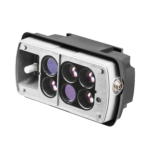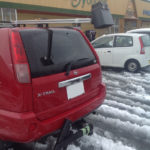Winter services save lives. They use salt spreaders and snow plows to ensure safe roads as soon as the days get shorter and colder and detect the road condition with real-time measurements. In a pilot project, the Technical Services Offenburg (TBO) show how their database can be improved with little effort.
It is a bus that makes traffic in Offenburg safer. All this without any additional effort for the driver. Yet the bus looks quite ordinary, only the frog-green varnish hits the eye. The crucial feature is located at the rear. It is a box the size of a bread box, inside of which there is an ingenious technology. The mobile road weather sensor Lufft MARWIS monitors the road condition while driving and sends the data in real time to the winter road clearance service. This is how the frog green bus detects the acute traffic safety when it tours the streets of Offenburg and the neighboring communities multiple times every day.
The importance of data for safety
One of the main tasks of winter road maintenance is to combat slippery roads. To do this, the workers use special vehicles to clear snow from the road and keep it rideable by spreading salt or alternative grit. Raphael Lehmann, Head of Technical Services at TBO, explains why the winter road clearance services need sensors for these tasks: “The data on the road condition helps us to quickly assess the situation on our roads and to prioritize operations”.
The MARWIS has been in operation in Offenburg since 2014. Meanwhile, eleven sensors are installed on TBO vehicles and monitor the road condition. Now the bus of the municipal transport company SWEG (Südwestdeutsche Landesverkehrs-AG) is the twelfth vehicle to be added. A true win-win situation for TBO and SWEG, says Lehmann. He summarizes the idea behind the pilot project as follows: “The buses drive their route anyway. By monitoring the situation on the roads without any additional effort, they feed our database, enabling us to work faster and more efficiently. This benefits all road users – including the SWEG buses.
Evolution of winter road maintenance: from shoe check to digital maps
Raphael Lehmann uses an example to explain how much modern road sensor technology can improve traffic safety. In the past, road monitoring was usually based on the experience of winter maintenance workers and was sometimes quite simple. “The employee would hold his foot out of the car and check how slippery the road was,” he says.
These days, workers look at a digital city map on which they can see real-time measurements from the sensors in use. The software recommended by Lufft is ViewMondo. Raphael Lehmann summarizes the work with the mobile road weather sensors in these words:
Both the driver and the winter service management can view the current road conditions in real time and evaluate within minutes whether further action is necessary or where the most urgent action is needed. In order to make the discussion of the current situation in the morning at 4AM as clear as possible, we have set up a traffic light system in ViewMondo. If it jumps to red in a district, our workers set off for a full service shift.
Raphael Lehmann, Technical Services Offenburg
A promising debut
The “MARWIS-Bus” in Offenburg is a pilot project that is likely to be followed by others. For example, DelDOT, the transportation authority of the US state of Delaware, – a satisfied customer for years – plans to use a MARWIS on a minibus. “There is a great deal of interest in this solution,” reports Steven Marks, Sales Manager for Lufft’s road weather solutions in German-speaking countries. “Wherever vehicles are on the road in urban areas, they could at the same time make a contribution to road safety without any effort”.
But what does the bus driver actually say about her new job? Edeltraud Himmelsbach is delighted with the new equipment of her work tool. “I think that’s very good. There are two or three places in our road network where it can get slippery quite quickly in winter. With the sensor, my colleagues and I are helping the winter service to make the roads safer.
Intercommunal cooperation for more traffic safety
The pilot project is scheduled for the fall and winter season 2020/21. For the future, Raphael Lehmann envisages equipping more buses and public vehicles with a MARWIS. In addition, he has in mind an intercommunal cooperation in which the data could be made available to neighboring communities. “Especially building yards in smaller villages, which do not themselves maintain road weather sensors but are part of the traffic area, would benefit from the collected data,” says Lehmann.
The evolution of winter maintenance has by no means reached the end of its development.









